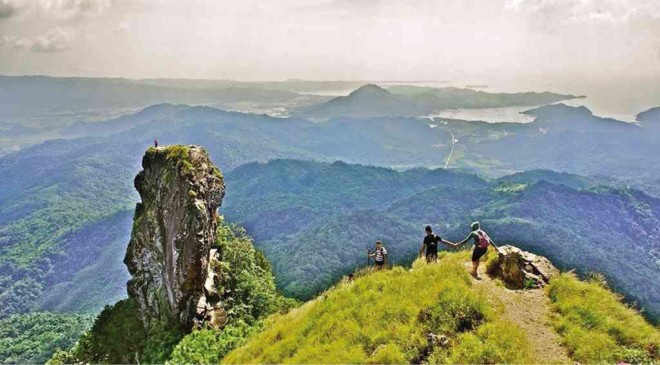
BREATHTAKING view of Batangas and Cavite provinces atop Pico de Loro in Maragondon, one of Cavite’s favorite hiking sites. JULIUS SANTOS/CONTRIBUTOR
Let me tell you how it goes,” said Jaime Diones, 50. “The story begins at Mt. Bahay na Bato (stone house), then Mt. Hagdan (staircase) and, of course, we have Mt. Silyang Bato (stone chair),” he said.
Diones, a hiking guide of seven years, was not talking about Spanish architecture. He was enumerating the names of some of the more popular mountain peaks in Maragondon town, Cavite province.
This was when his “story” started getting kinky. “Then we have Mt. Kandong, Mt. Bukatutan and Mt. Nagpatong,” which in Filipino, suggested sexual encounters.
“After that, Mt. Nagputok (eruption), then Mt. Tala,” Diones continued. The Inquirer interrupted him about the last one which sounded off-theme.
“Because the peak is reached and they say that’s when you see the stars,” he said. Another double entendre.
“Then Mt. Buntis (pregnant), Mt. Bunga (fruit) and Mt. Marami (plenty),” he said. “Maraming naging bunga (It bore plenty of fruits),” he added, letting out a small laugh.
Diones need not go further, especially when talking to mountaineers who found the names odd if not amusing.
“It makes them laugh. Some said I’m full of craziness, but once we arrive at the mountain, the people tell them that really is its name. They realize I’m not lying,” he said.
Diones, an employee at the municipal tourism office, said he did not make the names up. “They were there even before I was born,” but only a sequence to easily recall the names since Maragondon has more than 40 mountain peaks.
The local government, which is currently consolidating a tourism plan, has so far identified 38.
Maragondon tourism chief Louie Lagac said old folks believed the Katipuneros, who camped out in the woods during the Spanish revolution, were the ones who christened the mountains.
“The story guessed that such names came about because the Katipuneros were out there for a long time, away from their spouses,” he said.
But not all have sexual undertones. Others like Bundok ng Niyog, Mt. Lagundi and Mt. Kaykawayan—the town’s primary product is kawayan or bamboo—sound closer to nature.
Mt. Bahay na Bato, on the other hand, is believed to be an enchanted mountain, a dwelling place of spirits and used for interaction among community members.
Mt. Nagpatong, where a shrine of national hero Andres Bonifacio was erected, was the execution site of the Katipunan leader and his brother in 1897.
But the most commonly visited by hikers is Pico de Loro, named after a protruding rock resembling a parrot’s beak. However, it is often confused, even among mountaineering circles, as part of Ternate, the next town to Maragondon.
“It is just because the jump-off (to the hiking trail) is in Ternate, but no, it’s part of Marogondon,” Maragondon Mayor Rey Rillo said.
According to Lagac, a 1983 cadastral survey showed that the popular hiking site belongs to Maragondon.
Records from the Department of Environment and Natural Resources in Calabarzon (Cavite, Laguna, Batangas, Rizal and Quezon) also identified Pico de Loro, one of the peaks of the Palay-Palay-Mataas na Gulod protected landscape, as within the town’s territory.
“For years, past local officials neglected these mountains and now, our neighboring municipalities are claiming ownership (for instance) of Pico de Loro,” Lagac said.
Pico de Loro, alone, he said, draws around 200 hikers during weekends and around 700 during Holy Week, but the local income goes instead to the other towns.
Rillo said a congressional declaration over Pico de Loro could end the confusion. The town also plans to open a hiking trail from Maragondon, as well as develop trails for the rest of its other peaks.
The mayor agreed the mountains’ “unique” names could tick interests, but their actual tourist draws are the scenic views atop Maragondon peaks.
He found nothing to be ashamed of it either. “You know, Maragondon is one of the oldest municipalities (in Cavite) and so are the names.
“We even have a barrio, here, called Pantihan,” he quipped, pronouncing it in a way that sounded like the female’s underwear.

